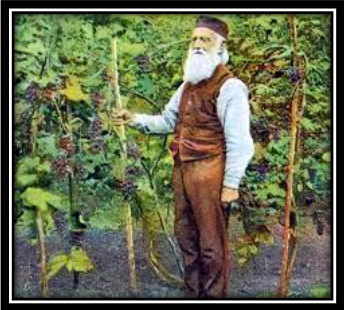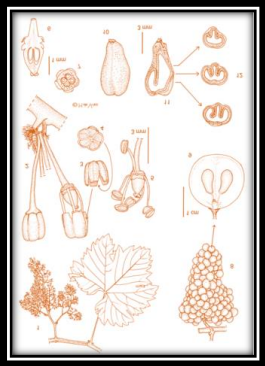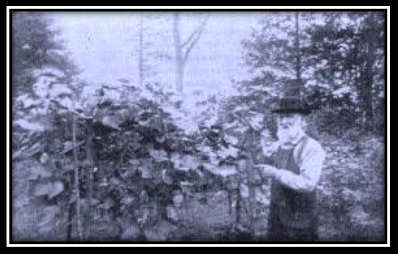REGULAR HOURS: TUESDAY-THURSDAY 12-6PM // FRIDAY & SATURDAY 12-8PM // SUNDAY 12-5PM // CLOSED MONDAYS
EXTENDED HOLIDAY HOURS: OPEN MONDAYS // THURSDAY - SUNDAY OPEN UNTIL 8p // CHRISTMAS EVE 9-2p // CLOSED CHRISTMAS
Click here for the full experience: the
original pdf-formatted version of this article.
Book of Bertil 1.09

PRELUDE:
Once Upon a Time...
The state of Massachusetts on the east coast of the UnitedStates of America is home to a small town called Concord. The inhabitants saved America and the world twice, first in 1775 by winning the first war victory against the British by Ephraim Wales Bull’s creation of the Concord grape variety. Y et the latter, unlike the Patriots of the Battle of the Minute Man, will receive neither national honor nor statue in his effigy for his exceptional contribution.
Chapter 1. Verse 1.101
The Hard Work of a Goldbeater Turned Botanist
Ephraim Wales Bull was born on March 4, 1806, in Boston. A very young Ephraim became an apprentice goldbeater (making gold into gold leaf) and made a career of it. At the age of 26 he married Mary Ellen Walker, and due to Mary’s failing respiratory health, they left the city in 1836 to settle in the countryside in the town of Concord, Mass., where Ephraim’s passion for horticulture led him to devote the rest of his life crossing grapevines (cloning) to create a new vine more resistant to the extreme cold and intense frosts of New England.

After more than 22,000 clones on 125 different native vine plants, it was in 1849 that he discovered a resistant plan that produced very sweet and aromatic grapes and adapted to the east coast’s soil and climate. Five years later in 1854 he presented his grape variety "The Concord" before the Massachusetts Horticultural Society where his reputation would become national and its spread dazzling, especially in the state of Texas and Missouri. Thanks to the preservation process developed by Mr. Thomas Welch (pasteurization of fresh grape juice), the Concord grape will grant immense fortune to the industrialists, but unfortunately not to Ephraim who will remain poor and unknown until the end of his life in 1895, yet his discovery has saved the wine world on a truly global scale

Little Note: Concord is a grape variety of the Vitis Labrusca family, a vine native to North America.
Chapter 2 Verse 2.101:
A Short Natural Story
Phylloxera vastatrix (Daktulospharia vitifoliae) is most likely native to the Caribbean or South America. It is a species of mite and a kind of aphid vine pest. The term phylloxera is also designated, by metonymy, the disease of the vine caused by the injection of Male and female insects mate in late summer. The female lays on the stumps a single egg called a winter egg. This egg, first yellow, then green during the winter season, hatches in spring and gives rise to the apterous (or wingless) phylloxera, which is always a female.

In most cases, this apterous phylloxera descends on the roots of the vine, at the expense of which it lives, hence its name of radicicol phylloxera; but it can sometimes go on the leaves, giving rise to galls (abnormal growths on leaves we refer to as gallicolous phylloxera).
Radicicol Phylloxera is yellow. It is equipped with a sucker that it pushes into the root to absorb the sap. He, or rather she, undergoes three molts in about twenty days, before becoming an adult and starting to lay between 40 and 100 eggs, giving all, too, birth to females, without fertilization. This is a case of the lytoc parthenogenesis. This twenty-day cycle repeats itself several times, giving a total of five or six generations.
The complete death of the vine is caused in a period of up to three years. But the biggest problem is its ability to spread at an exceptional speed. The devastating insect lives underground and therefore no pesticides or insecticides can eradicate it. It is still today the greatest devastator of vines in the world. The first observations on Phylloxera were made in the late 1860s by Charles Valentine Riley, an entomologist from Missouri.
Chapter 3 Verse 3.101
Meanwhile, in France...
In the history of the conquests of the European peoples over the peoples of the New World, the most devastating deadly consequences were mainly for the locals the avenue of highly contagious diseases such as malaria, tuberculosis, smallpox, etc. Phylloxera represents one of the rare examples where the New World devastated the Old World with the coming of an American plague, but in a completely different context.

Europe and mainly France at the time cultivated more than 99% of the vineyard plants of the Vitis Vinifera family (wine vines). These vines of Roman origin are genetically combative to locally existing vine diseases. The different mutations, cloning, and genetic manipulation of these plants created the basis of the different varieties of grapes and vines so prized in France at that time: Cabernet Sauvignon, Merlot, Malbec, Syrah, Pinot Noir, Sauvignon Blanc, Chardonnay etc.
Meanwhile, French, and American ampelographers and botanists are simultaneously passionate about understanding and creating new clones that would be more resistant or more productive. It is for this reason that in 1860 after an import of American plants (Vitis labrusca) planted in the south of France, appear the first signs of the plague of the vine. Its speed has spread, and the impossibility of finding a way to eradicate it will decimate more than 50% of French vineyards in less than 30 years. This pandemic is a national and economic disaster for France and later Europe.

The discovery of the consequences of this new disease will be made by the French botanist Jules Émile Planchon. This research will be published in botanical journals around the world, and it was in 1870 that Charles Valentine Riley of Missouri, after reading Planchon's research, communicated with him to inform him of his own observations. The disease did exist in Missouri and other parts of the USA. But unlike in France, American plants showed signs of disease on the leaves but no symptoms of death of the attacked plans. Then began an intense collaboration between the two men and the two countries.
They discovered that the American plants from the Concord strain are genetically resistant to the underground attacks of Phylloxera.

This is where an extraordinary adventure begins for this Vitis Labrusca native of Massachusetts. It was planted intensively in France and throughout Europe to replace the vitis vinifera vines with phylloxera, but its quality and unappealing foxy taste were not suitable for consumers, and France is afraid of losing its wine heritage. Then the hard work of botanists will make it possible to discover how to graft the cuttings of vitis vinifera on American Concord strains. The Concord did not adapt well to European soils and climates; it impoverishes the yields and quality of the grapes produced, and it was soon supplanted by the Vitis berlandieri, a hybrid of the Concord created by Thomas Volney Munson of Denison, TX, which adapted perfectly to French conditions.

It is then that those thousands of plants were shipped into France to be used as rootstock for the grafts of French vitis vinifera.
Even today the majority of` the world's vines continue to be on variants of the "Concord" rootstock. But the Concord itself, after its glory, was banished from France and considered a pariah. Today it exists only on common clones such as Vidal, Marechal Foch or Baco Noir.
Thank you, Mr. Ephraim Wales Bull, for saving the wine heritage of humanity. We are proud of you. I think it would be appropriate for the city of Concord to erect a statue in your likeness and honor your wine patriotism. Louis Pasteur has streets, public buildings, and effigies in his honor, so why not Ephraim Wales Bull?
Final Chapter, Verse 4:101:
Meditative Conclusion
Man is naturally stubborn and arrogant; they never tire of defying nature and ignoring the lessons of the past. By dints of manipulation and procrastination, it comes back around that America becomes sick of its own plague. The crossing of vitis vinifera and American vitis planted extensively in California, Oregon and Washington State has allowed Phylloxera to transform genetically and adapt to new American strains.
So, who will save the American vineyards of tomorrow - Asia, the Middle East or Africa? Or should we appeal (from his grave) to Ephraim Wales Bull that there is still a faith to save humanity again from its wine sarcasm?
An idea:
And then if we canonized Ephraim, it would at least allow us to dedicate ourselves to a Saint, so "God Bless Ephraim and the state of Massachusetts".
Mr. B
REGULAR HOURS: TUESDAY-THURSDAY 12-6PM // FRIDAY & SATURDAY 12-8PM // SUNDAY 12-5PM // CLOSED MONDAYS
EXTENDED HOLIDAY HOURS: OPEN MONDAYS // THURSDAY - SUNDAY OPEN UNTIL 8p // CHRISTMAS EVE 9-2p // CLOSED CHRISTMAS
